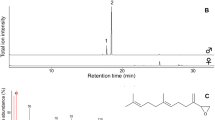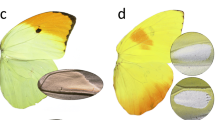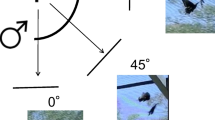Abstract
During successful courtship in sulfur butterflies, virgin females respond to males by assuming a stationary posture and extending the abdomen ventrally from between the hindwings, thereby permitting copulation. In the clouded sulfur,Colias philodice Godard, this response was used in a laboratory bioassay to confirm the existence of a male chemical signal demonstrated by a previous worker and to document the signal's behavioral function and source. The male scent is shown to be required, in part, to reliably elicit abdominal extension and to be emitted from a patch of cells and scales associated with the dorsal surface of the male hind wing near the wing base. Experiments also show that evaporation of the signal is reduced when the source is covered by the forewing as it is at rest and in flight. These data, coupled with other information on male chemical signals in sulfur butterflies and other Lepidoptera, suggest that in sulfurs the morphology and chemistry of the scent glands along with the behavior of the male are structured in a way that minimizes the evaporative loss of scent from the wings when the male is not courting females.
Similar content being viewed by others
References
Aplin, R.T., andBirch, M.C. 1968. Pheromones from the abdominal brushes of male noctuid Lepidoptera.Nature (London) 217:1127–1128.
Aplin, R.T., andBirch, M.C. 1970. Identification of odorous compounds from male Lepidoptera.Experientia 26:1193–1194.
Barrer, P.M., andHill, R.J. 1977. Some aspects of the courtship behaviour ofEphestia cautella (Walker) (Lepidoptera: Phycitidae).J. Aust. Entomol Soc. 16:301–312.
Barrer, P.M., andHill, R.J. 1978. The acceptance posture ofEphestia cautella (Walker) (Lepidoptera: Phycitidae) females, obtained in the absence of courting males.Experientia 34:343–344.
Birch, M.C. 1970a. Pre-courtship use of abdominal brushes by the nocturnal moth,Phlogophora meticulosa (L.) (Lepidoptera: Noctuidae).Anim. Behav. 18:310–316.
Birch, M.C. 1970b. Structure and function of the pheromone-producing brush-organs in males ofPhlogophora meticulosa (L.) (Lepidoptera: Noctuidae).Trans. R. Entomol. Soc. London 122:277–292.
Birch, M.C., Grant, G.G., andBrady, U.E. 1976. Male scent brush ofPeridroma saucia: Chemistry of secretion.Ann. Entomol. Soc. Am. 69:491–492.
Brower, L.P., Brower, J.V.Z., andCranston, F.P. 1965. Courtship behavior of the queen butterfly,Danaus gilippus brenice (Cramer).Zoologica (New York) 50:1–39.
Clearwater, J.R. 1972. Chemistry and function of a pheromone produced by the male of the southern armywormPseudaletia separata.J. Insect Physiol. 18:781–790.
Grant, G.G. 1974. Male sex pheromone from the wing glands of the Indian meal moth,Plodia interpunctella (Hbn.) (Lepidoptera: Phycitidae).Experientia 30:917–918.
Grant, G.G., andBrady, U.E. 1975. Courtship behavior of phycitid moths. I. Comparison ofPlodia interpunctella andCadra cautella and the role of male scent glands.Can. J. Zool. 53:813–826.
Grant, G.G., Brady, U.E., andBrand, J.M. 1972. Male armyworm scent brush secretion: Identification and electroantennogram study of major components.Ann. Entomol. Soc. Am. 65:1224–1227.
Grula, J., McChesney, J.D., andTaylor, O.R., Jr. 1980. Aphrodisiac pheromones of the sulphur butterflies,Colias eurytheme andC. philodice (Lepidoptera, Pieridae).J. Chem. Ecol. 6:241–256.
Klots, A.B. 1951. A Field Guide to the Butterflies. Houghton Mifflin Co., Boston.
Meinwald, J., Meinwald, Y.C., andMazzocchi, P.H. 1969. Sex pheromone of the queen butterfly: Chemistry.Science 164:1174–1175.
Meinwald, J., Thompson, W.R., Eisner, T., andOwen, D.F. 1971. Pheromones. VII. African monarch: Major components of the hairpencil secretion.Tetrahedron Lett. 38:3485–3488.
Myer, J.G. 1930. The epigamic behavior of a male butterfly (Terias) and the gregarious habit during resting of a heliconine butterfly, in Cuba.Proc. Entomol. Soc. London. 5:46–48.
Pliske, T.E., andEisner, T. 1969. Sex pheromones of the queen butterfly: Biology.Science 164:1170–1172.
Rutowski, R.L. 1978. The courtship of the small sulphur butterfly,Eurema lisa (Lepidoptera: Pieridae).Anim. Behav. 26:892–903.
Rutowski, R.L. 1978. The courtship of the small butterfly,Eurema lisa (Lepidoptera: Pieridae).Anim. Behav. 26:892–903.
Silberglied, R.E., andTaylor, O.R., Jr. 1978. Ultraviolet reflection and its behavioral role in the courtship of the sulphur butterfliesColias eurytheme andC. philodice (Lepidoptera, Pieridae).Behav. Ecol. Sociobiol. 3:203–243.
Taylor, O.R. 1972. Reproductive isolation inColias eurytheme andC. philodice: Random vs. non-random mating.Evolution 26:344–356.
Taylor, O.R. 1972. Reproductive isolation inColias eurytheme andC. philodice (Lepidoptera: Pieridae): Use of olfaction in mate selection.Ann. Entomol. Soc. Am. 66:621–626.
Tinbergen, N., Meeuse, B.J.D., Boersma, L.K., andVarossieau, W.W. 1942. Die Balz des Samtfalters,Eumenis (Satyrus) semele (L.).Z. Tierpsychol. 5:182–226.
Author information
Authors and Affiliations
Rights and permissions
About this article
Cite this article
Rutowski, R.L. Male scent-producing structures inColias butterflies. J Chem Ecol 6, 13–26 (1980). https://doi.org/10.1007/BF00987523
Received:
Revised:
Issue Date:
DOI: https://doi.org/10.1007/BF00987523




